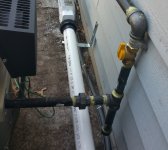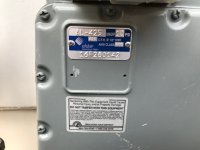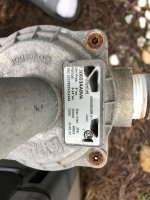Is it the shutoff valve is below the sediment trap? Similar to mine.Here’s our gas pipe (reduced from 1-1/4” arc-jacketed flex to 3/4” galvanized just prior to coming out of the wall.
View attachment 329862
Let’s see who can see what I did wrong (yet, somehow passed inspection)? I guess my mistake wasn’t critical, although I was fully prepared to address it on the spot.
Gas supply line issues for pool heater
- Thread starter cptkirk
- Start date
You are using an out of date browser. It may not display this or other websites correctly.
You should upgrade or use an alternative browser.
You should upgrade or use an alternative browser.
Candurin
Well-known member
- Jun 30, 2017
- 388
- Pool Size
- 13000
- Surface
- Fiberglass
- Chlorine
- Salt Water Generator
- SWG Type
- Pentair Intellichlor IC-40
Close. Gas valve should be before the sediment trap so you can shut it off to clear out the pipe. Having said that, we blew the pipe out before making final connections (+1 point for scuba tank!). I haven’t checked a single drip-leg in my house for over a decadeIs it the shutoff valve is below the sediment trap? Similar to mine.
So is the consensus that if I get this part of the supply cleaned up, and if the pressure is then within spec, that the flow should be sufficient for my heater even though the supply pipe is 1" rather than 1 1/4"?
Yes. Curious why you need a regulator. Is it code for your area?So is the consensus that if I get this part of the supply cleaned up, and if the pressure is then within spec, that the flow should be sufficient for my heater even though the supply pipe is 1" rather than 1 1/4"?
Candurin
Well-known member
- Jun 30, 2017
- 388
- Pool Size
- 13000
- Surface
- Fiberglass
- Chlorine
- Salt Water Generator
- SWG Type
- Pentair Intellichlor IC-40
Do you have any way of measuring your exact length of each diameter pipe? Then you can match up each section to a BTU chart. You only have 6’ (which will be less with correct pipe) of 3/4”, which should be ok as you need to convert to 3/4” to go into the heater valve anyway.So is the consensus that if I get this part of the supply cleaned up, and if the pressure is then within spec, that the flow should be sufficient for my heater even though the supply pipe is 1" rather than 1 1/4"?
As I’m typing this, I forget if you knew your meter/supply pressure. See if you can get that and the regulator output.
It is somewhere in the neighborhood of 50' of 1" pipe from the meter to the regulator when you account for the elbows (perhaps a little less). If I'm going to have new pipe installed, I guess I could go 1" until it makes the final turn into the gas valve so the 3/4" could be much less.
Candurin
Well-known member
- Jun 30, 2017
- 388
- Pool Size
- 13000
- Surface
- Fiberglass
- Chlorine
- Salt Water Generator
- SWG Type
- Pentair Intellichlor IC-40
He posted pics of his meter. It’s same rating as yoursIn addition to the possible restriction due to the flex pipe, it would be good to confirm that your gas meter is rated for 400BTU output. See my tag as an example showing 425.
View attachment 329958
MITBeta
Gold Supporter
- May 28, 2020
- 1,238
- Pool Size
- 13000
- Surface
- Vinyl
- Chlorine
- Salt Water Generator
- SWG Type
- CircuPool RJ-45 Plus
If the pressure from the meter to the regulator at the heater is anything greater than 0.5psi (6-8" WC), then the 1" pipe is not an issue. It's just the 3/4" between the regulator and the heater than would be restrictive. For that short of a distance, 3/4" is probably okay (but I don't have a pressure loss table in front of me).
A simple test you can do is turn off all your gas appliances and fire up the heater and then "clock" the meter to see if it's supplying all 400kBTU to the heater.
 hvactechhangout.com
hvactechhangout.com
A simple test you can do is turn off all your gas appliances and fire up the heater and then "clock" the meter to see if it's supplying all 400kBTU to the heater.
How to Clock a Gas Meter — HVAC Tech Hangout
Thanks for this suggestion, will try it tomorrow.A simple test you can do is turn off all your gas appliances and fire up the heater and then "clock" the meter to see if it's supplying all 400kBTU to the heater.
It appears to me that the meter is appropriately sized for the pool heater alone, but if one or both of our tankless water heaters happen to fire at the same time, we may have less gas available then we need. I will probably call the gas company to enquire about an upgrade. If they have to dig up my yard I may not do it, but if it's relatively simple then why not?
MITBeta
Gold Supporter
- May 28, 2020
- 1,238
- Pool Size
- 13000
- Surface
- Vinyl
- Chlorine
- Salt Water Generator
- SWG Type
- CircuPool RJ-45 Plus
The gas company would be only too happy to provide you with an appropriately sized meter. Again, assuming that the pressure at the meter is above low pressure, no digging should be required.
Candurin
Well-known member
- Jun 30, 2017
- 388
- Pool Size
- 13000
- Surface
- Fiberglass
- Chlorine
- Salt Water Generator
- SWG Type
- Pentair Intellichlor IC-40
Ours was “free” (they’ll get that money back when we heat our pool). They moled the pipe under the ground and you’d never know they did anything. Not so much as dead blade of grass.Thanks for this suggestion, will try it tomorrow.
It appears to me that the meter is appropriately sized for the pool heater alone, but if one or both of our tankless water heaters happen to fire at the same time, we may have less gas available then we need. I will probably call the gas company to enquire about an upgrade. If they have to dig up my yard I may not do it, but if it's relatively simple then why not?
I had to submit a form that listed every gas appliance with corresponding BTUs per. Then I listed the new pool heater and any FUTURE appliances we may want. They increased our incoming service line to 2” and gave us the new meter that can handle everything.
ChristopherDB
Gold Supporter
- Apr 21, 2021
- 122
- Pool Size
- 16000
- Surface
- Plaster
- Chlorine
- Salt Water Generator
- SWG Type
- Jandy Aquapure 1400
I'm a little late to chime in but I'll share with you what I did in Florida which was approved by my county.
I ran 3/4 polyethylene pipe underground 50ft to the heater and then further down a BBQ grill and patio heater (total of 200k BTU another 80ft past the heater) This was rated at 575k BTU total load and I upgraded the supply to 2 PSI.
Judging by your regulators I'd bet your service was already upgraded to possibly 2 PSI and the poly pipe you have is more than enough. Your permit docs would list your pressure or you could call your gas company. My only concern is the CSST which is not outdoor nor is it large enough.
I ran 3/4 polyethylene pipe underground 50ft to the heater and then further down a BBQ grill and patio heater (total of 200k BTU another 80ft past the heater) This was rated at 575k BTU total load and I upgraded the supply to 2 PSI.
Judging by your regulators I'd bet your service was already upgraded to possibly 2 PSI and the poly pipe you have is more than enough. Your permit docs would list your pressure or you could call your gas company. My only concern is the CSST which is not outdoor nor is it large enough.
Sorry I don't know what this means. Can you explain please?My only concern is the CSST which is not outdoor nor is it large enough.
ChristopherDB
Gold Supporter
- Apr 21, 2021
- 122
- Pool Size
- 16000
- Surface
- Plaster
- Chlorine
- Salt Water Generator
- SWG Type
- Jandy Aquapure 1400
The yellow flexible line that you have in a loop. It should be protected by a polymer jacket if it's outdoor rated, either a PVC sleeve or PS-II CSST.Sorry I don't know what this means. Can you explain please?
The plumbers also used similar flex outdoors to make the final connections to the tankless water heaters (looks similar externally, I haven't looked closely at the size of it). All of this presumably passed inspection. If it wasn't allowed outdoors, wouldn't it have been flagged? I'm just asking, these topics are beyond my knowledge.
ChristopherDB
Gold Supporter
- Apr 21, 2021
- 122
- Pool Size
- 16000
- Surface
- Plaster
- Chlorine
- Salt Water Generator
- SWG Type
- Jandy Aquapure 1400
Very good question and unfortunately I'm not experienced enough to know the specific details on why or why not. I do know that I bought a final connection yellow CSST for my BBQ grill but my gas guy refused to use it and instead told me to return it and used CSST that was insulated.The plumbers also used similar flex outdoors to make the final connections to the tankless water heaters (looks similar externally, I haven't looked closely at the size of it). All of this presumably passed inspection. If it wasn't allowed outdoors, wouldn't it have been flagged? I'm just asking, these topics are beyond my knowledge.
So I "clocked" the meter this morning while the pool heater (and nothing else) was running. It took just under 20 seconds for a full revolution of the 2 CF dial, which corresponds to 360 CFPH. If we use 1000 as the rough conversion factor, that's 360,000 BTU/hr. Since the time was just under 20 seconds, and the conversion factor is probably a little higher than 1000, that actually pulls it closer to 400,000. So if I'm interpreting this correctly, it would appear that the flow is not being seriously constricted even though the supply installation is kind of crappy.
Thread Status
Hello , This thread has been inactive for over 60 days. New postings here are unlikely to be seen or responded to by other members. For better visibility, consider Starting A New Thread.





